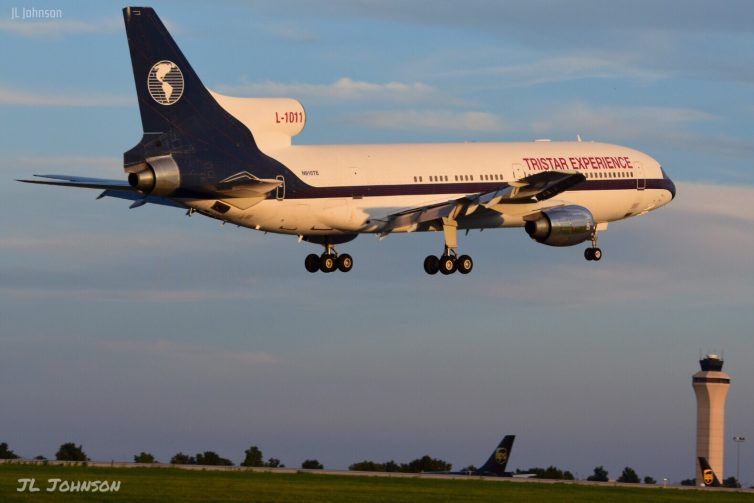
Lockheed L-1011 TriStar does a fly-by of Kansas City International Airport. – Photo: JL Johnson. Not for use elsewhere.
The Lockheed L-1011 TriStar was a plane with a tragically short lifespan. It was expected to be a real contender against the Boeing 747, Douglas DC-10, and Airbus A300. It entered the market late, in large part due to delays resulting from difficulty at Rolls-Royce, the only engine producer for the TriStar. Despite this, it is one of just a few airliners that elicits strong emotion from people of all ages and walks of life. It was received with much fanfare.
In business, however, fanfare does not necessarily equate to economic viability. In roughly two decades, just 250 units were produced – including an incredible number of custom variants. Few operators held onto their L-1011s for long before passing them along to others or sending them to storage. By most accounts, the TriStar was a failure. During development of the only TriStar engine option, the RB211, Rolls-Royce was deemed what modern day observers would call “too big to fail.” It was nationalized to avoid catastrophic economic impact to the United Kingdom and to keep the costly program afloat. Following the cancellation of the series, Lockheed fully withdrew from the commercial airliner market to focus on military and other industries.
But struggles in development, lackluster sales, and frequent turnover did not get in the way of the passion shared by those who had in some way experienced the TriStar. It was and is one of the most beloved planes in AvGeek culture. The TriStar was an underdog. People love an underdog story, and that is just what this is.

Artist Impression of Future Airport – Image: Lockheed-California Company
I have always been a fan of all things esoteric, the unique, and perhaps even the underdog. Engineering oddities fascinated me from a young age; if it was different or somewhat outlandish, I was hooked. For that reason, it’s probably no surprise to many people that the aircraft I adore more than all others (yes, even more than Concorde) is the Lockheed L-1011 TriStar.

The L-1011 prototype after completing her first flight on November 16, 1970 – Photo: Jon Proctor
However, I can take things a step further, because for me, this is more than an aircraft; it represents the engineering prowess of hundreds of engineers ’“ one of whom I happened to know very well. A man who was lucky enough to spend a lifetime in aviation working for some of the most storied aeronautical firms in history, such as Avro Canada (later Hawker Siddeley), Convair, De Havilland Canada, and Lockheed. Prior to his death in 2013, this engineer described the L-1011 as his ’œmagnum opus’, his greatest achievement as an engineer and the work that he was most proud of.

The twilight of the L1011 – refueling US Navy aircraft as part of Operation Enduring Freedom Photo: US Navy by Cmdr. Erik Etz
While 2014 may have been the end of commercial DC-10 services, many forget that the RAF (Royal Air Force) has been operating Lockheed L1011s (called “TriStars” in their parlance) as air-to-air refueling aircraft. Unfortunately for trijet enthusiasts, today marks the end of their service in the RAF. Even worse, they will be broken up in Bruntingthorpe.
As the resident Trijet Enthusiast – I was hoping for a little more notice from the RAF as to when the last RAF Tristar flight would happen. Thankfully, we have someone else who will be able to take the last flight and produce a fine report for AirlineReporter. As we await that final dispatch, let’s take a look back at the L1011 – an historical aircraft that even could have changed the pace of the Cold War.



